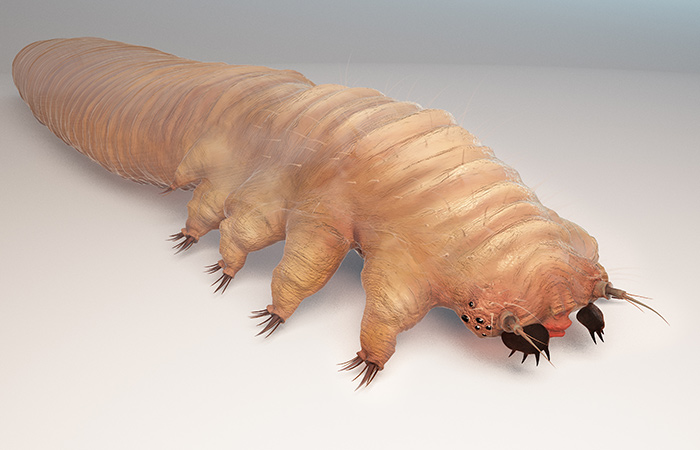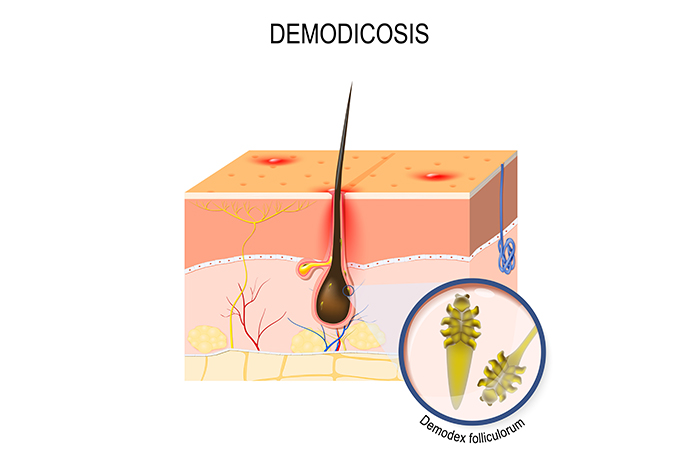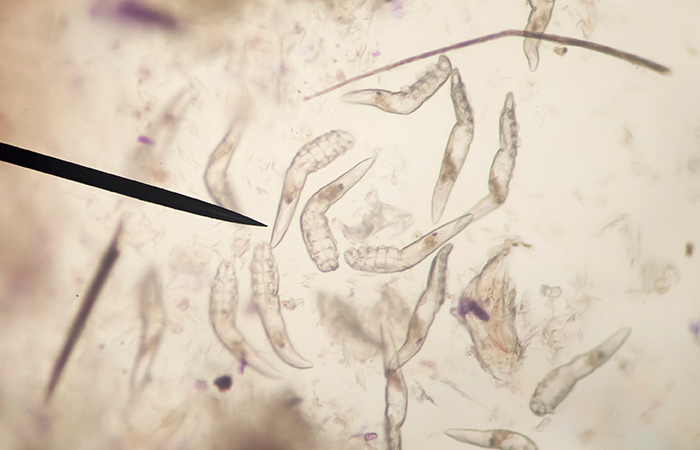Do you think your face is clean? Do you know there are thousands of eight-legged microscopic creatures crawling on your skin right now?
These are called face mites. These are constantly feasting on your skin oils, copulating, and producing offspring. These parasites thrive on human skin. But do they cause harm? If so, what can you do about it?
Face Mite Or Demodex Mite: What Is It?
Face mites or Demodex mites are obligate ectoparasites (parasites living outside the host’s skin that cannot complete their life cycle without a host) found on human skin. Demodex infestation is prevalent in humans.
In any healthy adult, the infestation of Demodex is between 23 to 100%. These mites stay on your skin without showing any symptoms. However, an imbalance in the number of these mites can cause certain skin issues (1).
There are about 65 species of Demodex, but only two of those are found on the human skin. These are:
- Demodex folliculorum (D. folliculorum): These are found in the hair follicles and on the face. They feed on dead skin cells and sebum. An excess of D. folliculorum on your skin can increase skin cells in your hair follicles, making your skin appear rough and scaly.
- Demodex brevis (D. brevis): Unlike D. folliculorum, D. brevis are not limited to the face alone. These mites are more commonly found on the neck and chest and have a wider distribution on your body. They get deeper into your sebaceous glands and ducts and feed on your gland cells.
These mites were first identified in 1841-42. Infestation of D. folliuculorum is more common in humans. These infestations increase with age.
Face mite infestation is the highest in individuals aged between 20 and 30 years. This can be attributed to the increased sebum secretion. Compared to females (13%), face mite infestation is much higher in males (23%) (1).
These mites can get transferred between hosts through physical contact (via nose, hair, eyebrows, etc.). They are mostly harmless and do not cause any symptoms. However, several external and/or internal factors (such as hereditary defects in T-cells and the immune system) may cause colonization of face mites, leading to certain skin conditions.
Face Mites: Causes, Symptoms, And Complications
You cannot get rid of face mites. They are always present on your skin. However, if they increase in number, they might cause several complications. Here are the symptoms of both types of face mites.
D. folliculorum
If your skin is infested with D. folliculorum, it will turn rough and scaly. D. folliculorum increases the number of skin cells in your hair follicles. Other symptoms of this infestation include:
- Skin redness
- Itchy skin
- Burning sensation
- Eczema
- Rough texture
- Skin sensitivity
These symptoms are common. Several factors can increase the risk of D. folliculorum infestation:
- Alopecia
- Weak immune system
- Dermatitis
- Skin infections
- Rosacea (loss of eyelashes)
Researchers are still investigating the relationship between D. folliculorum infestation and several other skin conditions. Some studies could establish a possible connection between D. folliculorum and rosacea. The skin condition could be a risk factor for Demodex infestation in the eyelashes (2).
D. brevis
If your skin is infested with D. brevis, it can appear red with rough patches. The most common symptoms of D. brevis infestation are:
- Burning sensation on the skin
- Redness
- Roughness
- Itchiness
- Rashes
- Changes in skin color
- Scaliness
Several factors can aggravate your risk of developing D. brevis infestation. These are:
- Rosacea
- Oily skin
- Eczema
- Acne
- Weak immune system
- Hair loss
Detecting face mites or Demodex is not quite easy. Most of us do not know of these parasites until they trigger symptoms, and we get our skin tested.
Diagnosing And Treating Face Mites
Skin biopsy can help diagnose the presence of face mites or Demodex. Doctors perform cyanoacrylic adhesion along with a biopsy to find out the density of face mites on your skin surface (1). They take a sample from your skin and examine it under the microscope.
This biopsy is needed if you are experiencing serious complications caused by severe infestation of face mites. Your doctor may suggest the following medications that can help minimize the infestation.
Medical Treatments For Face Mites
Keeping your skin clean is the first step to minimize face mite infestation (as they feast on your sebum and dead cells). You may also be prescribed the following medications:
- Salicylic acid
- Ivermectin
- Benzyl benzoate
- Crotamiton
- Permethrin
- Selenium sulfide
- Sulfur
- Metronidazole
The doctor might suggest topical or oral medication, depending on the severity of your infestation. If an underlying condition triggers the infestation (such as rosacea and eczema), you would need a separate treatment.
If the infestation is mild, you can treat it using simple home remedies.
Home Remedies For Face Mites
1. Tea Tree Oil
A study tested several ingredients on Demodex. Tea tree oil was found to be the most potent remedy for killing face mites, thanks to the presence of terpinen-4-ol (3).
How To Use
- Mix two to three drops of tea tree oil with any carrier oil and massage on your face.
- Leave it on for 30 minutes and then wash with plain water.
- Repeat two to three times a week.
The same study found that dill weed and caraway oils also help kill face mites. You may use these oils instead of tea tree oil.
2. Alcohol
A study found that 100% alcohol could kill face mites in just about 43.9 minutes (4). However, be careful while using 100% alcohol on your skin as it might cause skin irritation and contact dermatitis. Consult a doctor before using alcohol on your skin.
3. Neem
Research is limited here. However, it was found that neem could kill two other variants of Demodex found in dogs (5). You can give it a try and see if it works for you.
How To Use
- Boil neem leaves in water for a few minutes.
- Strain the water and store the decoction in a spray bottle.
- Spritz it on your face occasionally.
- You may also massage neem oil (mixed with any other oil) on your face.
Apart from these remedies, taking care of your skin and keeping it clean minimizes infestation. Follow these steps every day:
- As you wash your face and bathe daily, also wash your hair and keep your scalp clean.
- Use a non-soap and mild cleanser to clean your face. Focus on the eyelashes and eyebrows.
- Exfoliate your skin regularly to remove the dead skin cells and other impurities.
- Avoid using creams, gels, or lotions that make your skin oily.
Face mites have a short life span of just two weeks. They don’t poop as they do not have anuses (thankfully). However, they explode and die, spreading all the waste on your skin.
They thrive live in the greasiest parts of your skin, usually nestled inside your pores. When you are asleep, they crawl out to mate and then again go back again into the pores to lay eggs.
When their population is in control, these mites help in removing (or eating) the dead skin cells from your skin. You can only control their excess growth.
We know that everything about them sounds terrible. However, these microscopic guests staying on your skin aren’t really a potential threat unless any underlying reason triggers their growth.
Do you have any other questions about face mites? Let us know by leaving a comment in the box below.
5 sources
- “Human Demodex Mite: The Versatile Mite of Dermatological Importance” Indian Journal of Dermatology, US National Library of Medicine, National Institutes of Health.
https://www.ncbi.nlm.nih.gov/pmc/articles/PMC3884930/ - “Demodex and rosacea: Is there a relationship?” Indian Journal of Ophthalmology, US National Library of Medicine, National Institutes of Health.
https://www.ncbi.nlm.nih.gov/pmc/articles/PMC5778578/ - “Terpinen-4-ol is the Most Active Ingredient of Tea Tree Oil to Kill Demodex Mites” ARVO Journals.
https://tvst.arvojournals.org/article.aspx?articleid=2110345 - “In vitro and in vivo killing of ocular Demodex by tea tree oil” British Journal of Ophthalmology, US National Library of Medicine, National Institutes of Health.
https://www.ncbi.nlm.nih.gov/pmc/articles/PMC1772908/ - “Morphological characterization of demodex mites and its therapeutic management with neem leaves in canine demodicosis” Journal of Entomology and Zoology Studies.
http://www.entomoljournal.com/archives/2017/vol5issue5/PartI/5-4-135-212.pdf
The post Face Mites: Causes And How To Treat Them appeared first on STYLECRAZE.
from STYLECRAZE https://ift.tt/2MzPa4m
via IFTTT




No comments:
Post a Comment